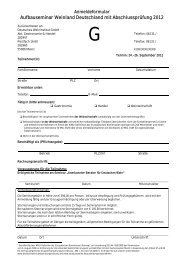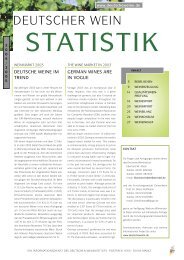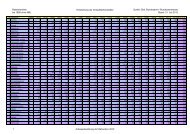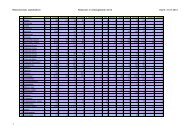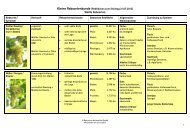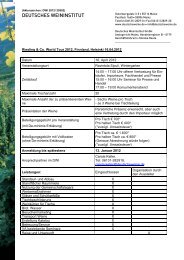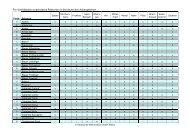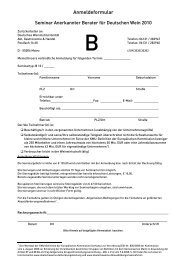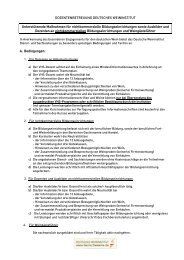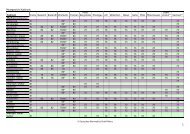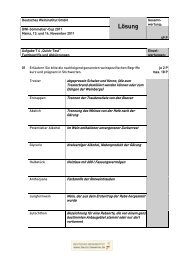DEUTSCHER WEIN - Deutsches Weininstitut
DEUTSCHER WEIN - Deutsches Weininstitut
DEUTSCHER WEIN - Deutsches Weininstitut
Create successful ePaper yourself
Turn your PDF publications into a flip-book with our unique Google optimized e-Paper software.
2<br />
0<br />
0<br />
8 EXPORT<br />
<strong>DEUTSCHER</strong> <strong>WEIN</strong><br />
www.deutscheweine.de<br />
www.germanwines.de<br />
DIE THEMEN<br />
iN DiESER AUSGABE<br />
„Spätburgunder: Germany’s Next<br />
Top Model!“ – der Gedanke liegt<br />
beim Durchblättern der internationalen<br />
Presseresonanz nahe:<br />
I n Ü b e r s e e b e g e i s t e r t s i c h<br />
E r i c A s i m o v z um B eispiel in<br />
www.the pour.blog.nytimes.com:<br />
“What struck me most of all about<br />
the wines there was how much I<br />
enjoyed the Spätburgunder“. Und<br />
Drinks international in Großbr<br />
itannien er kl är t: “Ger many<br />
makes some of the greatest white<br />
wines in the world and is a significant<br />
red wine producer, particular<br />
y Pinot Noir...these are<br />
world-class wines.“ Eine Auswahl<br />
weiterer Zitate finden Sie in den<br />
Ländersparten dieser Ausgabe.<br />
Gleichzeitig bleibt der Riesling<br />
im Fokus der inter nationalen<br />
B e r i c h t e r s t a t t u n g : V o n<br />
“Germany’s Top Rieslings“ ber<br />
i c htet B r u c e S a n d e r s o n i m<br />
Wine Spectator, Eric Asimov zeigt<br />
sich in der New York Times überrascht<br />
über die her vorragende<br />
iNHALT<br />
USA 2<br />
KANADA 3<br />
GROSSBRITANNIEN 4<br />
IRLAND 7<br />
BELGIEN 7<br />
NIEDERLANDE 8<br />
FINNLAND 8<br />
SCHWEDEN 9<br />
ASIEN 10<br />
INTERNATIONALE<br />
<strong>WEIN</strong>WETTBEWERBE 10<br />
Qualität trockener Rieslinge, in<br />
Belgien und den Niederlanden<br />
deuten die Fachzeit s chr if ten<br />
Officiële Horeca und Proefschrift<br />
einen Trend an: Sie beobachten,<br />
dass der neue interessante Wein<br />
heute aus Deutschland komme<br />
und sich in der Gastronomie zu<br />
einer festen Größe ent wickelt<br />
habe.<br />
F e r n e r w e r d e n die p o s i t i v e n<br />
Marktentwicklungen in den USA<br />
und GB in vielen Presseberichten<br />
thematisiert: In USA gilt Riesling<br />
zur Zeit als die Weißweinrebsorte<br />
mit der höchsten Wachstumsrate.<br />
In GB machen sich deutsche<br />
Weine in den oberen Preissegmenten<br />
bemer kbar: “...in the<br />
£ 4-5 categor y, Germany is the<br />
second-fastest growing country<br />
in the UK market with sales up<br />
22%. In the over £ 5 categor y<br />
Germany’s sales are up 31% - the<br />
third-fastest growth”, meldet u.a.<br />
das Fachblatt Off Licence News.<br />
Young German Winemakers: Leitz, Furst, Pfeffingen, Salwey, Deutschherrenhof<br />
Young German winemakers on<br />
tour<br />
by Tom Cannavan, 03/08<br />
I recently caught up with two members of Germany's young winemaking generation in<br />
Edinburgh, when the city's university was the final port of call in a nine date tour of british<br />
university wine clubs, organised by the Wines of Germany generic body.<br />
The idea was to introduce the UK's wine enthusiast students to the newer styles of German<br />
wine being made by younger winemakers, with the winemakers from estates like Leitz of the<br />
Rheingau, Rudolf Furst of Franken and Pfeffingen of the Pfalz talking about, and pouring, their<br />
wines for the audience.<br />
On this leg the task fell to Konrad<br />
Salwey of Weingut Salwey in Baden<br />
(left of picture), and Sebastian<br />
Oberbillig of Weingut<br />
Deutschherrenhof in the Mosel Valley<br />
(right of picture).<br />
The tour had taken in Oxford,<br />
Cambridge, Bristol and the LSE<br />
before wending its way north to<br />
finish with the universities of St<br />
Andrews and Edinburgh. I asked<br />
Konrad and Sebastian how it had<br />
gone, and both were impressed not<br />
just by the level of interest displayed<br />
by the students, but also their<br />
complete lack of any prejudice<br />
against German wines. It seems the<br />
notoriety of Liebfraumilch in the 70's<br />
has bypassed this generation, who<br />
come to German wine without<br />
negative preconceptions.<br />
That's not to say that Germany does not have a battle on its hands in terms of recognition: the<br />
fact that Germany made so many dry white wines not just from Riesling, but from Pinot Gris,<br />
Pinot Blanc and even Chardonnay was news to many. The fact that Germany makes increasing<br />
quantities of red wine was met with disbelief by some, though red varieties now account for<br />
37% of Germany's total grapevine acreage.<br />
This cleverly conceived road show comes against a very positive background for German wines.<br />
In the £4 to £5 category Germany is currently the second fastest growing country in UK wine<br />
sales, with sales up 22% between 2005 and 2007, whilst in the £5-plus category the increase is<br />
even more dramatic, with a 31% rise making Germany the third best performer in this category<br />
http://www.wine-pages.com/organise/young-german-winemakers.htm<br />
Seite 1 von 3<br />
“Young Germans on tour” – Eine<br />
DWI-Veranstaltungsreihe im Rahmen<br />
der Generation Riesling-Kampagne<br />
in England trägt zu einem<br />
positiven Medienecho bei.<br />
PRESSESPIEGEL<br />
AUSLAND<br />
Einige Zitate für den schnellen<br />
Blick<br />
Tom Cannavan, GB,<br />
wine-pages.com:<br />
“Riesling has finally started to<br />
gain mass appeal.“<br />
Natasha Hughes, GB, OLN:<br />
“Britain finally seems to be<br />
embracing German wine”.<br />
Howard G. Goldberg, USA,<br />
Wine News:<br />
“Riesling has finally begun to<br />
challenge Chardonnay’s dominance.”<br />
Eric Asimov, New York Times:<br />
“Drinking through almost two<br />
dozen dry German rieslings...<br />
I was stuck by the high quality.”<br />
Peter Blattmann, Kanada,<br />
Opulence Magazine:<br />
“The future looks good for this<br />
under-appreciated grape, and<br />
the quality-to-price ratio of<br />
good Riesling is outstanding.”<br />
Alain Bloeykens, Belgien,<br />
Het Nieuwsblad:<br />
“Riesling meest geerde witte<br />
druif.”<br />
Eric Asimov, USA,<br />
the pour.blogs.nytimes.com:<br />
“German spätburgunders deserve<br />
far more attention than<br />
they get ... they are worth seeking<br />
out.”<br />
Jim Clarke, USA,<br />
StarChefs.com:<br />
“Germany’s Turn on the Red<br />
Wine Shelf: ...the grape to look<br />
out for is Spätburgunder”.<br />
>><br />
EIN INFORMATIONSDIENST DES DEUTSCHEN <strong>WEIN</strong>INSTITUTS · POSTFACH 16 60 · 55006 MAINZ<br />
13.06.08 10:14<br />
Tom Cannavan's wine-pages.com<br />
HOME FORUM TASTED NEWS FEATURES RESOURCES GUESTS FOOD SUBSCRIBE ADVERTISE ABOUT<br />
tasting note search organised tastings meet the winemakers wines of the month value wines wine of the week
Wine Spectator<br />
„Germany’s Top Rieslings“/<br />
“Extreme Rieslings“<br />
Bruce Sanderson, April 30, 008<br />
”There are loads of appetizing wines from among<br />
the more than 475 2006 Rieslings blind-tasted in<br />
Wine Spectator’s New York office since my last<br />
report on Germany...The vintage’s top wines show<br />
opulence and seamless harmony from star t to<br />
finish..... If 2006 created headaches for growers in<br />
Germany, 2007 was much less nerve-racking. The<br />
har vest delivered both qualit y and quantit y. In<br />
contrast to its predecessor, 2007 looks like a classic<br />
kabinett and spätlese year. In the meantime,<br />
enjoy the many lush and charming Rieslings of 2006<br />
this spring and summer, and stock up on 2006<br />
botr y tis bottlings while waiting for the crisper<br />
kabinett and spätlese wines of 2007. Twenty years<br />
from now you will reap the benefits.”<br />
The New York Times<br />
“German Rieslings, Light and Dry”<br />
Eric Asimov, 3. April 008<br />
“This year I’m craving dry German rieslings. Dry?<br />
Many Americans assume all rieslings are sweet.<br />
In fact, most rieslings, whether from Austria, Alsace,<br />
Australia or the United States, are dry. Even<br />
more surprising is the fact that many German<br />
rieslings are dry, too and the performence in Germany<br />
today and for the last 20 years has overwhelmingly<br />
been for dry riesling. But the most surprising<br />
thing to me is how delicious dr y Ger man<br />
rieslings have become.”<br />
“In fact, drinking through almost two dozen dr y<br />
German rieslings over the last few weeks I was<br />
stuck by the high quality. How did they get so good?....<br />
Now, a generation of German winemakers reared<br />
on dry wines is pursuing the style with thought and<br />
care. Oh, and global warming, which has made it<br />
possible to ripen grapes more fully in this extreme<br />
northern grape-growing region, hasn’t hurt. ... So<br />
strong is the performence for dry wines in Germany<br />
these days that Mr. Theise, for one, is concerned<br />
that the riesling with residual sugar will be crowed<br />
out. ‘Why, when there are other sources for worldclass<br />
dr y riesling’, he asked, ‘should Germany<br />
focus on being a member of an ensemble when with<br />
her table wines with residual sugar, she is not<br />
only a soloist but an all-time great one?’<br />
USA<br />
<strong>DEUTSCHER</strong> <strong>WEIN</strong><br />
EXPORT<br />
It’s a good question, and the prospect of losing<br />
those wines should be cause for great concern.<br />
Still, I can’t help but think that dry German rieslings<br />
are singular in their own way, combining grace,<br />
delicacy and power in a way that nobody else’s dry<br />
rieslings can do. One can only hope, that the world’s<br />
taste for German rieslings with residual sugar will<br />
keep those styles in business, even if Germany<br />
itself no longer cares.”<br />
Wine News<br />
“The other white wine”<br />
Howard G. Goldberg,<br />
March/April/May 008<br />
Howard G.<br />
Goldberg besuchte<br />
auch<br />
das Riesling &<br />
Co.-Tasting<br />
2008 in New<br />
York.<br />
“Patience began<br />
paying<br />
off. Riesling<br />
caught on<br />
across North<br />
America. In the<br />
year ended January 12, 2008 sales in food stores<br />
rose 22 percent. Despite, or perhaps because of,<br />
Riesling’s rich theme and variations, it has finally<br />
begun to challenge Chardonnay’s dominance, though<br />
not equally in all US markets. A historically unliked<br />
string of superior vintages in Germany... has contributed<br />
to Riesling’s rising popularity. Smitten<br />
young sommeliers, especially those rebelling against<br />
the tastes of preceeding generations, are honing<br />
the cutting edge. They address Riesling’s identity<br />
problems.”<br />
“Riesling’s emergence as America’s fastest-growing<br />
white has spawned three separate programs to<br />
promote it coast to coast. The latest is a European<br />
Union plan, organized and run by the German Wine<br />
Institute, to market German, Austrian and Alsace<br />
Rieslings together equally. Second the formation<br />
of the International Riesling Foundation, which is<br />
in its infancy. Third is the Riesling Rendezvous.”<br />
“Today most Riesling fans buy to drink. The next<br />
stage, to use an equities market phrase, is buy and<br />
hold. Tasting a beautifully aged German Riesling<br />
for the first time is like the first encounter with the<br />
exquisite theme of ‘Der Rosenkavalier’.”<br />
/08
thepour.blogs.nytimes.com<br />
“Germany, Red Wine”<br />
Eric Asimov, March 31, 008<br />
“Even those who know something of German wines<br />
are primarily focused on riesling, as they should<br />
be. Riesling is the great glory of German winemaking<br />
without doubt. Still, with the attention being paid<br />
to pinot noir, German spätburgunders deserve far<br />
more attention than they get. ... I just returned<br />
recently from five days in Berlin, and what struck<br />
me most of all about the wines there was how much<br />
I enjoyed the spätburgunders.... German pinot noirs<br />
are not so easy to find in the United States but<br />
they are worth seeking out if only to sample a very<br />
different – and to me, at least, more recognizable<br />
“Sensational and versatile wines<br />
from Germany“<br />
So heißt es in der Überschrift des LCBO-Kataloges<br />
zur Vorstellung der “New Releases“ (10.05.2008).<br />
“Vintages invites you to discover the best kept<br />
secret that every good sommelier knows: the incredibly<br />
food-friendly and vivacious wines of Germany.”<br />
“The future looks good”<br />
“The future looks good for this under-appreciated<br />
grape, and the quality-to-price ratio of good Riesling<br />
is outstanding”, erklärt Peter Blattmann in<br />
seinem Beitrag für das Opulence Magazin, Calgary<br />
(Januar/Februar 2008). Aus einer DWI-Informationsreise<br />
sind zwei Artikel über die Pfalz und den<br />
Riesling hervor gegangen: “The palatable palatinate“<br />
und “One grape – endless possibilities“.<br />
KANADA<br />
<strong>DEUTSCHER</strong> <strong>WEIN</strong><br />
EXPORT<br />
– expression of pinot noir ....if you want graceful<br />
wines with lightness and finesse then the word is<br />
spätburgunder.”<br />
StarChefs.com<br />
“Germany’s Turn on the Red Wine Shelf”<br />
Jim Clarke, April 008<br />
“Aren’t Germany’s wines already famous? Well,<br />
Riesling, sure. But like Austria, Germany’s never<br />
really convinced anyone about their red wines.<br />
That’s changing, and the grape to look out for is<br />
Spätburgunder. If you’re sick to death of learning<br />
new grape names, you could also call it what the<br />
rest of the world does: Pinot Noir.”<br />
„The good German“<br />
Dan Kislenko informiert im Hamilton Spectator<br />
(10.05.08) und anderen Tageszeitungen über das<br />
neue LCBO-Vintages-Angebot, das zeitgleich zur<br />
Toronto German Wine Fair in die Läden gelangte:<br />
“Key regions offer quality whites of great value“,<br />
erklärt Kislenko, der auch zu den Juroren des Best<br />
of Riesling- Wettbewerbes gehören wird, in der<br />
Headline. “The one thing every wine drinker looks<br />
for is value: Good wine at an affordable price. I’ve<br />
long thought, and written numerous times, that the<br />
best value available here is German wine. I’m talking<br />
entr y-level wines that consistently deliver<br />
exceptional quality and upscale bottles that arrive<br />
with price tags well below what I think they’re<br />
wor th..... What an oppor tunity it is that a small<br />
group of wines from key regions in Germany has<br />
arrived on Vintages shelves. There’s something for<br />
every taste and budget.”<br />
Sechs Weinjournalisten und Sommeliers<br />
bereisten in der ersten Juniwoche gemeinsam<br />
mit dem DWI die Anbaugebiete Rheingau,<br />
Rheinhessen – hier im Bild bei einem<br />
Abstecher in die Weinberge des Weingutes<br />
Gunderloch -, Pfalz, Mosel und Nahe.<br />
3 /08
GROSSBRiTANNiEN<br />
<strong>DEUTSCHER</strong> <strong>WEIN</strong><br />
EXPORT<br />
Briten entdecken die “plus points of German wine“<br />
Das aktuelle Presseecho für deutsche Weine in Großbritannien ist von Aufbruchstimmung geprägt.<br />
Dies ist sowohl aus Fachmedien als auch Internetportalen sowie Tages- und Publikumsmedien zu entnehmen.<br />
Christian Davis, Drinks International, arbeitete die Pluspunkte des deutschen Weines heraus.<br />
“On a mission for recognition“<br />
”.... on the wine front, while Germany makes some of the greatest white<br />
wines in the world and is a significant red wine producers, particularly<br />
Pinot Noir,..., it is still, to an extent, saddled with the image of making<br />
cheap and cheerful, sweet glugging wines. This is undoubtedly<br />
changing, and while many consumers still have that perception, the<br />
trade is starting to wise up.... The reality is that outside the wine trade,<br />
only well-heeled wine buffs will know that not only is Germany a<br />
major Pinot Noir producer – the third largest in the world – but that<br />
these are world-class wines.”<br />
“All three (Anmerk.: Schritz, Wagner, Hübinger) plus Schindler extol<br />
the new breed of winemakers in Germany. Better educated, well travelled<br />
and therefore more willing to experiment and consider new ideas<br />
– the new mantra is quality over quantity.”<br />
“Wines of Germany has, without doubt, been successful in focusing<br />
the trade on Riesling as the way forward and more discerning wine<br />
drinkers have responded. The lack of awareness by consumers of<br />
German reds will make Pinot Noir a tougher nut to crack and risks the momentum behind Riesling.<br />
Pushing its whites – the other Pinots, Weissburgunder... and Grauburgunder ... – may be a safer bet”.<br />
(Christian Davis, Drinks International, März 2008)<br />
“ 0 0 Vision: Tesch”<br />
Paul Howard, Mitglied der Association of Wine Educators und als solcher auch Teilnehmer der DWI-Informationsreise<br />
im April, verfasste für www.winealchemy.com eine Story über Martin Tesch, Weingut<br />
Tesch in Langenlonsheim/Nahe unter dem Titel “2020 Vision: Tesch“: „His story is one of the relentless<br />
pursuit of a singular, truly 2020, vision. This is the story of Weingut Tesch – a triumph of terroir over<br />
adversity.”<br />
(Paul Howard, www.winealchemy.com, 04.06.2008)<br />
/08
“Britain finally seems to be embr acing<br />
German wine.”<br />
Natasha<br />
Hughes, die<br />
an einer<br />
DWI-Pressefahrtteilnahm,<br />
hat<br />
positive<br />
Eindrücke<br />
zum deutschen<br />
Wein<br />
mitzuteilen.<br />
”...most<br />
producers,<br />
when asked<br />
about their<br />
prospects<br />
in the UK,<br />
sighed,<br />
shrugged<br />
and said<br />
words to<br />
the effect of<br />
“It’s tough.” But figures recently published by<br />
Nielsen suggest that there’s light at the end of the<br />
tunnel for Germany’s winemakers. Even though<br />
volumes of expor ts to the UK are growing only<br />
slowly .... the value of the country’s sales is really<br />
on the up. In the £ 4-5 categor y, Germany is the<br />
second-fastest growing country in the UK market<br />
with sales up 22%. In the over £ 5 category, Germany’s<br />
sales are up 31% - the third-fastest growth...”<br />
“I have to say that I’m changing my mind”, he (Anmerk.:<br />
Nick Weis/St. Urbans-Hof) says. “The recent<br />
orders I‘ve received from my UK importer show<br />
that interest is picking up, especially in the ontrade.<br />
I think it’s similar to the way the market<br />
developed in the US, where sommeliers in top<br />
restaurants led the way and the market followed.<br />
I’m ver y sure that within the next five years, the<br />
UK consumer will be actively looking for high-end<br />
German Riesling.”<br />
“...Weis’ conviction that the development of the UK’s<br />
appetite for German wines is going to start with a<br />
trickle-down effect from the on-trade. If he’s right,<br />
German wines may finally be on the cusp of their<br />
long-awaited revival.”<br />
(Natasha Hughes, Off Licence News, 21.03.2008)<br />
The Grocer: “The £ 5-plus category may be the<br />
saving grace for Germany... The stats show<br />
Germany is in very good company in the £ 4-plus<br />
market”.<br />
(The Grocer, May 5 2008)<br />
“Young Germans on tour”<br />
<strong>DEUTSCHER</strong> <strong>WEIN</strong><br />
EXPORT<br />
www.winepages.com/organise/young-german-winemakers.htm,<br />
31.03.2008<br />
To m C a n n a v a n<br />
traf Konrad Salw<br />
e y ( W e i n g u t<br />
S alwey/ B aden)<br />
u n d S e b a s t i a n<br />
Oberbillig (Weingut<br />
Deutschherrenhof/Mosel) anlässlich des University<br />
Wine Club-Tasting in Edinburgh: ”...Germany<br />
does not have a battle on its hands in terms of<br />
recognition: the fact that Germany made so many<br />
dr y white wines not just from Riesling, but from<br />
Pinot Gris, Pinot Blanc and even Chardonnay was<br />
new to many. The fact that Germany makes increasing<br />
quantities of red wine was met with disbelief<br />
by some, though red varieties now account for 37%<br />
of Germany’s total gr apevine acreage. ... This<br />
clearly conceived road show comes against a very<br />
positive background for German wines. In the<br />
£ 4-5 categor y Germany is currently the second<br />
fastest growing country in the UK.... Another interesting<br />
statistic suggests that Riesling – so long<br />
the favourite grape of many wine-lovers but one<br />
that made no impact on general consumers – has<br />
finally started to gain mass appeal. German exports<br />
have attained their highest ever volumes and the<br />
highest prices on record.”<br />
(Tom Cannavan, www.wine-pages.com)<br />
“Most people who love wine, love<br />
Riesling”<br />
“Natasha Hughes has a passion for Riesling. Here,<br />
she gets together with wine columnist Victoria<br />
Moore to investigate matching Riesling to Food.”<br />
“Most people who love wine, love Riesling. Some<br />
of us even buck the trend and love German Riesling.<br />
For many, though, the joys of Kabinett and Feinherb<br />
remain a mystery. So what better way, I thought,<br />
of uncovering the delights of German wines than<br />
by doing a little food and wine matching exercise?”<br />
(Natasha Hughes: “Riesling Bites”, 03/08, w w w.<br />
wine-pages.com; Victoria Moore, “German Riesling”,<br />
The Guardian Weekend, 22.03.2008)<br />
/08
“A sense of change is in the air with<br />
passionate winemakers”<br />
Rosie Bainbridge ist Educator, Wine-Tour-Organiser<br />
und schreibt für das Derbyshire Life & Countryside-<br />
Magazin. Faszinier t von den Weinen der Mosel,<br />
kommentier t sie nach einer DWI-Inforeise mit<br />
Mitgliedern der Association of Wine Educators:<br />
”There are German wines for every taste and occasion<br />
but nothing is more pleasurable than a glass<br />
of lightly chilled, refreshingly fruity Mosel on a<br />
warm, heady summer day. In June.... a light German<br />
wine is perfect. The best is made from Riesling<br />
grapes...”.<br />
“On a recent trip to the Mosel vineyards I had the<br />
opportunity to taste many stylish Rieslings<br />
and can repor t that these are<br />
exciting times. A sense of change is<br />
in the air with passionate winemakers<br />
who are committed to producing<br />
high quality wine and deter-<br />
mined to see the renaissance of<br />
Rieslings. “<br />
“ To day ther e’s a c all for<br />
dryer styles of German wine<br />
that are suited to food, lower<br />
in alcohol, and are just perfect<br />
for a summer’s day ...bliss.”<br />
(“German wine ideal for a glorious<br />
June”, Rosie Bainsbirdge, Derbyshire<br />
Life & Countryside, 01.06.2008)<br />
“Resurgence in German<br />
wine...”<br />
Harry de Quetteville informierte sich bei der Pro-<br />
Wein über den deutschen Wein. Unter anderem<br />
beruft er sich in seinem Artikel auf Jonathan Ray,<br />
Wine Columinst des Daily Telegraph, mit den Worten:<br />
“It’s high time we rediscovered our taste for<br />
German whites. German Rieslings are remarkably<br />
diverse: dry, off-dry, sweet with a steely minerality<br />
or voluptuous honeyed fruit...”.<br />
(Harry de Quetteville, Berlin: “Resurgence in German<br />
wine driven by British palates”, The Daily<br />
Telegraph, 25.03.2008)<br />
Für das Monatsmag<br />
a z i n “ E s q u i r e” h a t<br />
Anthony Quinn im Mai den<br />
Pinot Gris thematisiert. Der<br />
Artikel schließt mit einer Kaufempfehlung.<br />
Drei Weine – aus<br />
Neuseeland, USA und Deutschland<br />
– haben ihn besonders angesprochen,<br />
darunter ein Grauburgunder aus dem<br />
Weingut Dr. Heger, Baden.<br />
E squire wird monatlich von<br />
rund 162.000 Menschen ge-<br />
lesen, vor allem karrier<br />
e b e w u s s t e n M ä n -<br />
nern.<br />
<strong>DEUTSCHER</strong> <strong>WEIN</strong><br />
EXPORT<br />
“There’s nothing more refined than a<br />
Riesling”<br />
“German wines have a reputation for being cheap<br />
and naff. But there’s nothing more refined than a<br />
Riesling”, findet Tim Atkin. So die Überschrift im<br />
Observer Magazine vom 20. April 2008.<br />
„..maybe opinions are beginning to change. I think<br />
there are three reasons for this. First Riesling,<br />
Germany’s best grape, is increasingly recognised<br />
as one of the world’s greatest.... Second, many<br />
German wines, even at the commercial end, are<br />
dry and better suited to modern palates. And lastly,<br />
the increasing popularity of New World Rieslings<br />
has been a boon for the grape’s home from home.<br />
Following a good to great run of vintages<br />
in 2004, 2005 and 2006, many consu-<br />
mers are starting to rediscover the<br />
best German wines, which remain<br />
comparatively under-priced.”<br />
“To enthuse the non-Riesling<br />
drinkers among you, I’ve chosen<br />
a half dozen examples this<br />
week, three from Germany<br />
and three from the New World<br />
– all of them dry...”<br />
(Darting, Horst Sauer,<br />
Heyl zu Herrnsheim).<br />
(„Liquid gold“, Tim Atkin,<br />
The Oberserver Magazine,<br />
20.04.2008)<br />
“if you think you know German winemakers,<br />
think again“<br />
Mike Tipping lernte während einer DWI-Pressefahrt<br />
deutsche Weinproduzentinnen (z.B. Theresa Breuer,<br />
Yvonne Gräfin von Schönburg-Glauchau, Barbara<br />
Roth, Stefanie Weegmüller) kennen. So bietet<br />
er dem Leser eine neue Perspektive an, unterstrichen<br />
auch durch Abwandlung des DWI-Slogans: “If<br />
you think you know German wine(makers), think<br />
(drink) again“.<br />
“Forget any pre-conceived ideas that all German<br />
wine is sweet. I’m a huge fan of German riesling in<br />
its many guises, from bone-dry styles to the nectar-like<br />
eisweins, in fact I’d go as far as saying<br />
it was my favourite wine of all. There are some<br />
examples to be found in the supermarkets, names<br />
like Ernst Loosen, and Josef Leitz can usually be<br />
trusted.”<br />
(Mike Tipping: “Wine women, song“, Yorkshire<br />
Living, Mai 2008)<br />
/08
iRLAND<br />
Guter Start für Wines of Germany<br />
Das K ick-Of f-Event des neu etablier ten DWI-<br />
Informationsbüros in Dublin war von guter Stimmung<br />
begleitet.<br />
Der Weinjournalist der irish Times (10.05.2008),<br />
John Wilson, findet: “Riesling is a rewarding grape,<br />
once you surrender your snobber y.” Er kommt<br />
zudem auf eine weitere, internationale Verkostung<br />
zu sprechen: “I was surprised to see that seven of<br />
my top 10 wines were from Germany, mostly names<br />
I had never heard”.<br />
“German Wines Star t to Soar“, titelt im Mai die<br />
Fachzeitschrift Retail News. “Jean Smullen reports<br />
on the revival of German wines in the Irish market“,<br />
heißt es weiter. “In the UK, sales are soaring at the<br />
INFORMATIEBUREAU VOOR DUITSE WIJN<br />
BUREAU D’INFORMATION DU VIN ALLEMAND<br />
BELGiEN<br />
Der Neue Wein kommt aus Deutschland<br />
Uitgave / Edition : De Officiële Horeca<br />
Datum / Date : 01/04/2008<br />
Pagina (‘s) / Page(s) : 23<br />
Oplage / Tirage : 19.200<br />
Uitgave / Edition : Culinaire Saisonnier<br />
Datum / Date : 12/04/2008<br />
Pagina (‘s) / Page(s) :<br />
Oplage / Tirage :<br />
Het Nieuwsbald<br />
(12.04.2008):<br />
Riesling meest gegeerde<br />
witte druif<br />
– Alain Bloeykens<br />
Die belgische Tages- und Fachpresse<br />
findet im April anerkennende<br />
Worte über den deutschen<br />
Wein: De Officiële Horeca kündigt<br />
INFORMATIEBUREAU VOOR DUITSE WIJN<br />
BUREAU D’INFORMATION DU VIN ALLEMAND<br />
an: „Der neue Wein kommt aus<br />
Deutschland.“ Katia Belloy findet<br />
nämlich, dass die deutschen Weine<br />
inzwischen die anspruchsvollen<br />
<strong>DEUTSCHER</strong> <strong>WEIN</strong><br />
EXPORT<br />
top end, where German wines are the third fastest<br />
growing sector behind Italy and New Zealand, with<br />
sales up 31%. Here in Ireland, too, German wines<br />
have become less of a myster y to consumers as<br />
evidenced by the increase in their market share....<br />
Speaking at the launch of the Wines of Germany<br />
Campaign, Manuela Liebchen... said, “While this<br />
development is positive, we feel strongly that German<br />
wine can and will do much better than the current<br />
market share, which is why we opted for direct<br />
representation in Ireland”... To date, many Irish<br />
oenophiles still have an outdated image of German<br />
wines. In recent years, however, a large-scale image<br />
and quality overhaul has taken place, with wines<br />
such as Black Tower and Bend in the River changing<br />
forever the image of German wine in Ireland.”<br />
Geschmackspapillen der Belgier<br />
erobern, nicht die Neue Welt und<br />
schon gar nicht mehr Frankreich<br />
und Italien.<br />
(01.04.2008, Auflage 19.200)<br />
Von „Deutscher Metamorphose“<br />
und dass „junge Winzer kräftig<br />
die Trommeln rühren“, spricht<br />
Culinaire Saisonnier, denn die<br />
deutsche Weinszene befinde sich<br />
zur Zeit in voller Bewegung. Vor<br />
allem junge qualitätsbewusste<br />
Erzeuger stünden im Rampenlicht.<br />
Ihr Qualitätsstreben werde<br />
w e l t w e i t w a h r g e n o m m e n .<br />
(01.04.2008, Auflage: 24.000)<br />
„Riesling – die begehrteste Weißw<br />
e i n t r a u b e“ s c h w ä r mt A l a i n<br />
Bloeykens in der größten belgischen<br />
Tageszeitung Het Nieuwsblad<br />
(12.04.2008, Auflage: 241.120).<br />
Seit Robert Parker den Riesling<br />
entdeckt habe, könnten die deutschen<br />
Winzer der Nachfrage kaum<br />
noch Herr werden.<br />
/08
NiEDERLANDE<br />
„Duitse wijnen en gastronomie“<br />
„Deutsche Weine in der Gastronomie“ titelt ein umfangreicher<br />
Beitrag Jan van Lissums in Proefschrift Wine<br />
& Food Professional.<br />
In den letzten Jahren habe die Rolle der deutschen<br />
Weine in der niederländischen Gastronomie stark an<br />
Bedeutung gewonnen, beobachtet van Lissum. Seiner<br />
Ansicht nach auch zurecht, denn Deutshland verfüge<br />
über ein enormes Potenzial an charakter- und stilvollen<br />
Weinen, die vielseitig einsetzbar sind. In diesem Zusammenhang<br />
denke er zudem nicht nur an Riesling.<br />
<strong>DEUTSCHER</strong> <strong>WEIN</strong><br />
EXPORT<br />
Van Lissum schließt noch ein Wor t über die jungen<br />
Restaurantfachkräfte und die Arbeit des Informatiebureau<br />
voor Duitse Wijn an: So mache es sich für den<br />
deutschen Wein positiv bemerkbar, dass junge Mitarbeiter in der Gastronomie heute dem internationalen<br />
Weinspektrum gegenüber offen eingestellt sind und überkommene Ansichten bei Weinen des 21.<br />
Jahrhunderts inzwischen keine Rolle mehr spielen. An den positiven Entwicklungen haben auch Gisela<br />
und Alain Jacobs maßgeblichen Anteil, schreibt van Lissum. Sie engagieren sich mit viel Erfolg, um<br />
deutsche Weine begehrt zu machen. So sei Deutschland inzwischen auch nicht mehr aus der Gastronomie<br />
wegzudenken. Es biete ein breites Weinangebot diverser Rebsorten in den unterschiedlichsten<br />
Preisklassen.<br />
(Proefschrift Wine & Food Professional, 30.04.2008)<br />
„Notities Pinot Noir buiten<br />
Bourgogne“<br />
Perswijn hat sich des Spätburgunders angenommen:<br />
Aus aller Welt wurden Spätburgunderweine<br />
verkostet und die besten mit Bewertung aufgelistet.<br />
In den USA habe ja seinerzeit der Kinofilm<br />
Sideways den Pinot Noir-Konsum maßgeblich stimuliert,<br />
heißt es in der Einführung. Den Perswijn-<br />
Testern imponierten besonders Chile und Neuseeland,<br />
wenn man sich die Newcomer anschaut. Und<br />
in Europa dürfe auf keinen Fall Deutschland vergessen<br />
werden, betonen sie. Denn dort treffe man<br />
auf wirklich prächtige, dem Burgunder vergleichbare<br />
Pinot Noir-Weine!<br />
(Perswijn,<br />
30.04.2008)<br />
Für Reise-<br />
u n d L i f e -<br />
style-Journ<br />
a l i s t e n -<br />
unser Bild<br />
z e i g t v . l .<br />
Karin Kuijpers,<br />
Robert<br />
Verkerk und Janna Rijpma – von der Presseagentur<br />
ANP, vom Algemeen Dagblad und den Zeitschriften<br />
Spits, ZIN und Cosmopolitan - gestaltete das DWI im<br />
Mai eine Themenreise „Wine & Wellness“ in den Anbaugebieten<br />
Mosel, Nahe und Pfalz.<br />
Publicatie: Proefschrift Wine & Food Professional<br />
Oplage: 10000 Datum: 30/04/2008 Mediawaarde: 3450,00 EUR<br />
FiNNLAND<br />
Dit knipsel is geselecteerd op: DUITSLAND ALLEEN IVM WIJN OOK RECEPTEN ALG.INFO ALLEEN DUITSLAND GEEN ELZA<br />
alleen voor intern/eigen gebruik<br />
Reinhard Löwenstein, Weingut Heymann-Löwenstein/Mosel,<br />
referierte im März im Rahmen der<br />
ViiniExpo in Helsinki über deutsche Rieslinge.<br />
Darauf beruft sich die größte finnische Tageszeitung,<br />
Helsingin Sanomat, in ihrer nur donnerstags<br />
er s cheinenden Wein-& Food-S onder r ubr ik .<br />
(13.03.2008)<br />
10667|01746|028.00|00<br />
8 /08
SCHWEDEN<br />
Systembolaget-Launch und gute Presseresonanz<br />
gehen Hand in Hand<br />
“March saw the largest Systembolaget launch of German wines ever<br />
in Sweden. Close to 50 wines were launched and several were sold out<br />
shortly afterwards”, meldet das DWI-Informationsbüro aus Stockholm<br />
im Zusammenhang mit einer Presseauswertung für das erste Quartal<br />
2008. Tatsächlich standen zahlreiche Meldungen über das neue deutsche<br />
Weinangebot bei Systembolaget in den großen schwedischen<br />
Tageszeitungen und Nachrichtenblättern, in regionalen Gazetten<br />
sowie Lifestyle—und Gourmetzeitschriften. So verfasste Anders<br />
Röttorp bspw. einen ganzseitigen Ar tikel in Dagens industri<br />
(29.02.08, Auflage 115.000); Elke Ljung schreibt zu diesem Thema<br />
in Norbottens Kuriren (28.02.08, 26.800), Bengt Göran Kronstam<br />
ä u ß e r t s i c h e nthusiastisch i n D a g e n s N y h e t e r ( 2 4 . 0 2 . 0 8 ,<br />
368.100).<br />
Darüber hinaus fallen auch Features in Folge von DWI-Pressefahrten<br />
ins Auge, wie zum Beispiel der Themenfahrt „Women and<br />
Wine“, die Jan Petersén für das Livets Goda-Magazin sehr ansprechend<br />
aufbereitete (10.04.2008, 30.000).<br />
Ein Artikel von Jens Dolk im Svenska Dagbladet (18.01.08, 186.400)<br />
ist ferner erwähnenswert: Dolk meldet, dass Riesling im nunmehr<br />
zweiten Jahr in Folge zur „Rebsorte des Jahres“ gewählt wurde<br />
und befasst sich insbesondere mit Weinen aus ökologischem Anbau.<br />
Anders Röttorp hat zudem den “greatest wine of the past 100<br />
years“ ausfindig gemacht - Wehlener Sonnenuhr vom Weingut J.<br />
J. Prüm/Mosel. (Dagens industri, 14.03.08, 115.000).<br />
Weitere Artikel greifen ferner Trinkempfehlungen zu schwedischen<br />
und internationalen Speisen auf. Dazu folgende beiden Beispiele<br />
aus der aktuellen Presseschau: Lantliv – eine Zeitschrift für Leben<br />
im Landhausstil (18.03.08, 40.700) empfiehlt deutsche Weine<br />
zur Küche von Jamie Oliver. Punkt.se (04.04.08, 93.000) entdeckte<br />
feinherbe deutsche Rieslinge zu Gemüsevarianten in der Frühj<br />
a h r s k ü c h e .<br />
Der Expres-<br />
Julia Metzler<br />
z u G a s t b e i<br />
S t o c k h o l m s<br />
Bürgermeister<br />
Bo Bladholm.<br />
A l s G a s t g e -<br />
schenk überr<br />
e i c h t e d i e<br />
j u n g e W e i n -<br />
prinzessin einenSpargelkor<br />
b und ein<br />
W e i p r ä s e n t .<br />
Julia Metzler<br />
gab auch ein ausführliches Inter view für die<br />
schwedische Radiosendung „Menu“ mit einer<br />
geschätzten Hörerschaft von rd. 400.000.<br />
sen (14.04.08,<br />
218.200) findet,<br />
dass zu<br />
Spargel und<br />
Sauerkr aut-<br />
G e r i c h t e n<br />
d e u t s c h e<br />
W e i n e a m<br />
<strong>DEUTSCHER</strong> <strong>WEIN</strong><br />
EXPORT<br />
Dieser Artikel erschien in Folge der<br />
international besetzten DWI-Themenpressefahrt<br />
„Women & Wine“ im Livets<br />
Goda-Magazin. Es ist einer von 35<br />
bemerkenswerten Berichten in einer<br />
Gesamtauflage von r d. 4 ,2 Mio im<br />
ersten Quartal 2008.<br />
besten passen. Bengt Fritihiofsson erinnert in der<br />
Svensk Damtidning an den Rivaner (10.04.08, 141.400).<br />
Ihm gefiel ein badischer Rivaner von Karl Johner<br />
besonders gut.<br />
Allt om Mat, das hochwertige Wein- und Gourmetmagazin,<br />
rückt die Larsson-Brüder in den Fokus (8<br />
Seiten, 06.03.08, 131.500). Das Magazin begleitete<br />
Radioredakteur Mattias und Sommelier World Champinon<br />
Andreas Larsson in der Küche und bei der<br />
Weinauswahl (u.a. von Georg Breuer und Kloster<br />
Eberbach).<br />
/08
ASiEN<br />
Korea Times über “German<br />
World“<br />
Die deutsche<br />
Leistungsschau:<br />
German World<br />
und den Besuch<br />
der Deutschen<br />
Weinkönigin in<br />
Seoul kündigte<br />
die Korea Times<br />
an.<br />
Spargelgerichte und deutsche<br />
Weine für japanische<br />
Journalisten<br />
Die Verbindung von Spargelgerichten und deutschen<br />
Weinen griff die CMA mit Unterstützung<br />
des DWI am 14 Mai im Grand Hyatt Hotel in Tokio<br />
auf. Hier nahmen 27 japanische Journalisten von<br />
Koch-, Lebensmittel- und Gourmetpublikationen<br />
teil. Der Chefkoch des Hyatt-Hotels, Budde, präsentierte<br />
und erläuterte diverse Gerichte, vornehmlich<br />
rund um den Spargel, aus Deutschland.<br />
Ehrengast aus Deustchland war der Parlamentarische<br />
Staatssekretär des BMELV, Dr. Gerd Müller,<br />
der zu diesem Zeitpunkt eine Wirtschaftsdelegation<br />
nach Japan führte.<br />
Chefkoch<br />
Budde, Grand<br />
Hyatt Hotel,<br />
steht JournalistinnenRede<br />
und Antwort.<br />
e Dr. Gerd<br />
Müller richtet<br />
Grußworte an<br />
die Vertreter der<br />
Presse.<br />
<strong>DEUTSCHER</strong> <strong>WEIN</strong><br />
EXPORT<br />
iNTERNATiONALE<br />
WEiNWETTBEWERBE<br />
VINITALY, Verona 2008<br />
www.vintaly.com<br />
Die höchste Auszeichnung der Vinitaly – „Gran<br />
Vinitaly“ ging im April 2008 an die Winzergenossenschaft<br />
Divino Nordheim eG in Franken.<br />
Annette Droll, für Export<br />
und Öffentlichkeitsarbeit<br />
zuständig, und der Aufsicht<br />
sr at s v o r sit zende<br />
Winfried Glos sind stolz<br />
auf diese höchstmögliche<br />
Prämierung der 105-köpfigen<br />
Vinitaly-Fachjury.<br />
In Franken erhielt zudem<br />
die Winzergenossenschaft<br />
Thüngersheim den Vinitaly-Länderpreis<br />
Deutschland. Große Goldmedaillen<br />
erzielten die Winzer Sommerach – der Winzerkeller<br />
sowie die Winzergemeinschaf t Fr anken<br />
(GWF).<br />
Concours Mondial de Bruxelles 2008<br />
(www.concoursmondial.eu)<br />
Gold:<br />
Weingut Heyl zu Herrnsheim, Weingut Wagner,<br />
Weingut Aufricht<br />
Silber:<br />
Weingut Dr. Hinkel (2x),<br />
Gebiets-Winzergemeinschaft Franken eG<br />
Wein- und Sektgut Bernd Hummel<br />
Cisterzienser Weingut Michel<br />
Weinmanufaktur Untertürckheim<br />
Challenge International du Vin, Bourg<br />
(www.challengeduvin.fr)<br />
Deutschland erzielte 11 Medaillen, davon 5 mal<br />
Silber und 6 mal Bronze :<br />
Silber:<br />
Winzergenossenschaft Auggen eG, Winzergenossenschaft<br />
Thüngersheim eG, Winzergenossenschaft<br />
Burkheim eG, Weingut Brennfleck, Gebiets-<br />
Winzergemeinschaft Franken eG<br />
Bronze:<br />
Winzergenossenschaft Auggen eG (2x), Privat-<br />
Weingut Schmitt (2), Gebiets-Winzergemeinschaft<br />
Franken eG, Weingut Wehrhof<br />
10 /08
Les Citadelles du Vin, Bourg<br />
(www.lescitadellesduvin.fr)<br />
Throphée Citadelles:<br />
Weingut Werner Anselmann,<br />
Weinkellerei Reh Kendermann GmbH<br />
Trophée Excellence:<br />
Weingut Gebrüder Anselmann<br />
Trophée Prestige:<br />
Weingut Werner Anselmann,<br />
Weinkellerei Reh Kendermann GmbH<br />
Chardonnay du Monde, Chaîntré<br />
(www.chardonnay-du-monde.com)<br />
Silber:<br />
Weingut Peter Stolleis,<br />
Winzergenossenschaft Auggen eG<br />
Bronze:<br />
Weingut Martin Wassmer<br />
Gewürztraminer du Monde 2008, Straßburg<br />
www.gewuerztraminer-du-monde-com<br />
Bei dem soeben in Straßburg zu Ende gegangenen<br />
Wettbewerb „Gewür ztraminer du Monde 2008“<br />
wurde das Weingut Hiestand aus Guntersblum mit<br />
einer von vier Exzellenz-Trophäen, der höchsten<br />
Auszeichnung überhaupt, in der Kategorie „Top-<br />
Jahrgang vor 2005“ für einen Guntersblumer Eiserne<br />
Hand Gewürztraminer Eiswein prämiert.<br />
IWSC - International Wine and Spirit<br />
Competition 2008 (www.iwsc.net)<br />
Gold (Best in Class):<br />
Bürgerspital zum Hl. Geist, Weingut Horst Sauer,<br />
Weingut Schmitt’s Kinder, ZGM<br />
Gold:<br />
Weingut J. Störrlein<br />
Außerdem wurden 29 Silber (Best in Class)-Prämierungen<br />
sowie 17 Silber- und 49 Bronzemedaillen<br />
für deutsche Weine vergeben.<br />
<strong>DEUTSCHER</strong> <strong>WEIN</strong><br />
EXPORT<br />
IWC - International Wine Challenge 2008<br />
(www.internationalwinechallenge.com)<br />
Bei der diesjährigen International Wine Challenge<br />
wurden insgesamt 160 deutsche Weine prämiert,<br />
davon 10 mit einer Goldmedaille.<br />
Gold erielten die Weingüter Losen-Bockstanz (2x),<br />
St. Urbanshof, Juliusspital, Horst Sauer, Hans Lang,<br />
Josef Leitz, das Fürstlich Castell’sche Domänenamt<br />
und die Vier Jahreszeiten Winzer eG (2x).<br />
Decanter Wine Awards 2008<br />
(www.decanter.com/world wine awards/<br />
2008/dwwa_search.php)<br />
Sweet Germany Trophy over £ 10:<br />
Schloss Reinhartshausen<br />
Red Germany Trophy over £ 10:<br />
Weingut Meyer-Näkel<br />
Gold:<br />
Weingut Martin Wassmer,<br />
Weingut Bürgerspital zum Hl. Geist<br />
Silber:<br />
Weingut Dr. Loosen, Weingut Mar tin Wassmer,<br />
Weingut Fritz Allendorf, Weingut Fritz Waßmer,<br />
Weingut Josef Leitz, Weingut Juliusspital (3x),<br />
Weingut Matthias Gaul, Weingut Meyer-Näkel,<br />
Weingut Prinz von Hessen,<br />
Weingut Reichsgraf von Kesselstatt,<br />
Weingut Reichsrat von Buhl (2x),<br />
Weingut St. Urbans-Hof, Weingut Zum Eulenturm<br />
Korea Wine Challenge 2008<br />
(www.koreawinechallenge.com)<br />
Nach Deutschland ging eine Bronzeauszeichnung<br />
für eine 2006 Riesling Beerenauslese des Weingutes<br />
Dr. Loosen.<br />
Herausgeber + Copyright: <strong>Deutsches</strong> <strong>Weininstitut</strong> GmbH Juni 2008<br />
Redaktion: Ulrike Spengel-Rückrich (Angaben ohne Gewähr)<br />
11 /08



